#MR NGUYEN I OWE YOU MY LIFE
Text


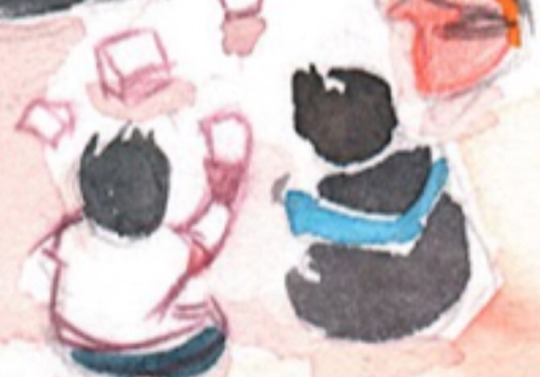
Rereading Li’l Gotham and missing Jason being drawn like this and also the antagonistic vibe!!!!!!!!!!
#I’m rereading for Harvey ngl#coz I read this when I JUSTTTT started obsessing over Jason/Jaydick#so everything was tunnel visioned towards him/JD#but as I have better appreciation for the rogues nowadays#this series is absolutely adorable AHHHH#AND DAMICOLIN DAMICOLIN DAMICOLIN#I LOVE THEM SO MUCHHHHHHH#jaydick#MR NGUYEN I OWE YOU MY LIFE#FOR DRAWING ONE OF THE HANSUMEST JASON AND HARVEY#AND FOR MAKING HARVEY WEAR BLACK
157 notes
·
View notes
Text
BoJack Horseman: 5.2 The Dog Days Are Over
Kay, we ended episode 5.1 with the Goldfish Ladies doin’ their thang in BoJack’s pool. Aside: if their water ballet team isn’t called the Goldfish Ladies, I’ma be disappoint.
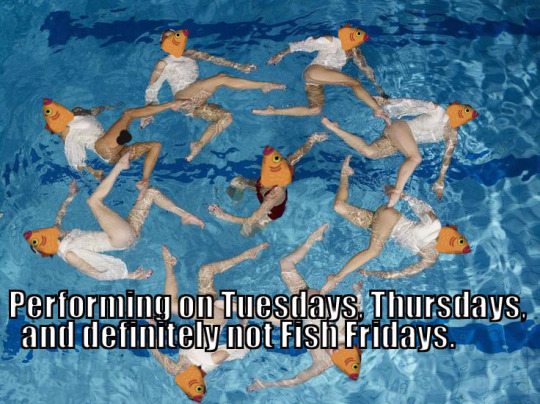
Fish Fridays have gotta be like The Purge for these ladies.
We also left off, at the tail end of the episode, with Diane and Mr. Peanutbutter. He was dropping her off at her new, um, let’s just call it “not a mansion in the Hollywoo Hills” after a trip and giving her a set of signed divorce papers.
“Take *that*, our marriage!” she joked awkwardly before leaving.
So, Diane and Mr. Peanutbutter are friendly but awks around each other. As tends to happen when exes who’ve seen each other nekkid many, many times try to stay friends with each other.

The episode starts with Diane crying in her car, mascara running down her face. She is wearing an outfit that is very unDianeish and she has cut her hair short. AKA the post-breakup haircut all girls know and eventually come to regret.

As poor Diane is cryin’ her eyes out over her canine ex-husband, uh, this happens:
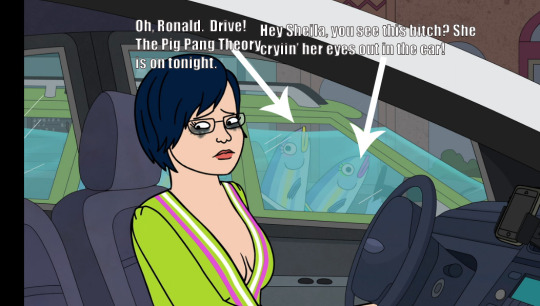

This couple must be transplants from the underwater land BoJack went to for the premiere of Secretariat in season 3.
Still crying, Diane heads to the airport and asks to be taken as far away from Los Ageless as possible. She demands this of the airport attendant, who is an emu.

After the title sequence, Diane lands in Vietnam, and as she is walking through Hanoi, dodging people and reptiles alike (look, conspiracy theorists! lizard people!), Stefani calls, salivating for fresh content. Diane, if you remember, is a contributer at the website Girl Croosh, which I guess is a site for, like, everything.
She promises to write something up from there, the article of which becomes the Top 10 Reasons Why You Should Travel To Vietnam
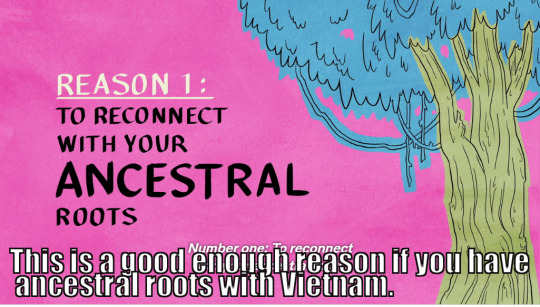
I, personally, do not have ancestral roots with Vietnam...as far as I know. I took one of those Ancestry DNA tests a few weeks ago and am waiting on the results. As far as I know I could be 15 percent Tongan, which would be awesome.
I should visit Germany. Or Austria. Or Russia. Those I know I have roots to. Really close roots. Munich-y roots. My dad’s side of the family were from a valley near the Caucasus Mountains. I am literally Caucasian.
Sometimes, I don’t know whether to interested in the rich history or saddened and embarrassed at how white that is.
In VO, Diane explains that her family wasn’t much help in explaining to her where they came from when she was growing up, or their family history. We are shown a flashback of pre-teen Diane inquiring to her dad about just this, but he is busy with baseball. Likely a Red Sox game. Or a Red Fox game.
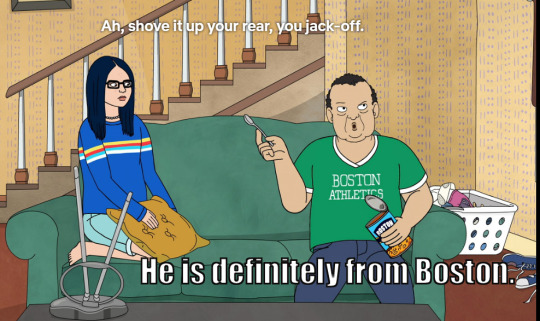
Furthermore, many of the stores and billboards bear her last name.


I know. Many people in Vietnam share surnames. One of my friend’s last name is Nguyen.
Everybody she passes, Diane continues, look like her (except the flamingo in the nón lá hat).But then a woman bumps into her and speaks Vietnamese to her and she has no idea what she’s saying.
At the gorgeous (cartoon) hotel, Diane checks in just as a gang of American filmmakers bust in; they are filming a movie in the hotel. It stars Laura Linney as a recently divorced woman who comes to Vietnam to find herself.

So much for escaping the LA life.
Diane puts on the dress she bought and the rice paddy hat but she still feels like a tourist.
Speaking of tourist--

Cut to Diane in her usual clothes plus the rice paddy hat appearing to take a selfie in front of the Thien Mu Pagoda.Then everything zooms out.

Pretending to be somewhere more awesome than where you actually are to make other people jealous of you on social media? The hell you say, that never happens!

Diane eats her chicken in the park when Mr. Peanutbutter calls, and, in his usual Mr. Peanutbutter way, inquires as to why she left his party early. He was gonna ask earlier but he was distracted by Todd getting his tongue stuck to the ice sculpture. Todd’s tongue swelled up, and Mr. Peanutbutter had to interfere between him and a mob boss when Todd started talking to him all muffled, the mob boss thinking he was making fun of his deaf sister.
Ya, don’t blame the mob boss.

She makes up an excuse about having a plane to catch to Vietnam while Mr. Peanutbutter literally catches his newspaper in his mouth like a good boy and he promises to pick her up like a good boy/ex-hubby. He is also glad that he is not paying for her phone bills anymore because that international call is gonna be bazongers


Wah wah wahhhhhh as joke falls flat.
In flashback, a still longhaired Diane and Mr. Peanutbutter, recently separated, are celebrating how friendly their separation is by having a divorce dinner. Their waitress turns out to be an excitable young pug by the name of Pickles and I need to call my next dog that. Not fit for a pug, tho. Maybe a dachshund.

She and Mr. Peanutbutter seem to hit it off right away, much to Diane’s annoyance. They both like water! And food scraps! And are full of boundless energy! Amazing! Diane just wants to know if he’s signed the divorce papers yet. Then suggests a housewarming party to curb his loneliness.
Back in the Bojackverse present, a family of American tourists dressed in American flag shirts and polos mistake Diane for a Vietnamese citizen and talk to her like she’s an idiot.
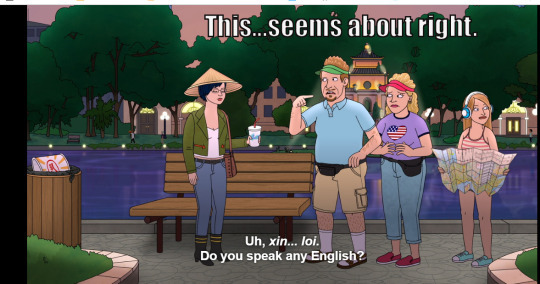

Yup yup yup. Reminds me of the tourist from California who carved her initials into the Roman Colosseum and then took a selfie.
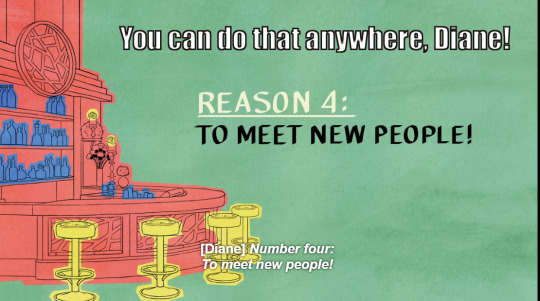
I can go a few streets over and meet new people, Diane!
This is a bad reason to travel to Vietnam, Diane!
The internet exists, Diane!

At the hotel bar, Diane meets one of the only other Americans staying there, a dude working on Laura Linney’s movie about the recently divorced woman going to Vietnam to find herself. He appears to be a bald eagle, but we do not know that he is indeed bald because he is wearing a hat.
He is likely bald, tho.

I mean, unless people start fake tanning and fist-pumping there. Then I’d feel right at home.

In flashback, Diane hangs a painting of the gorgeous Te Huc Bridge at the Hoàn Kiếm Lake in her crappy new apartment just as BoJack stops by. While helping her move, he, in true blunt BoJack fashion, informs her that this place is a shithole and invites her to stay at his place for a bit. She likes the shithole though. It may be a shithole, but it is her shithole.

At Girl Croosh HQ, Stefani is signing a contract outside of their be-tented building. It seems that the “cockroaches at IT tried to unionize” so Stefani called an exterminator--ahem, “negotiator”. The exterminators, natch, are flies. She also requires that listicle from Diane of 5 Empowering Roles For Women Over 40 Who Would’ve Been Better Played By Jennifer Lawrence.

Somehow, I predict that role opposite that (now 58) year old actor Maggie Gyllenhaal didn’t get because she was told she was “too old” to play his love interest at the shocking age of 37 will go to JLaw. She’s, like, 28 now! That’s almost thirty!

Still in flashback, Diane’s trying to get work done in her shithole when a pipe leaks and a stray cat meows and someone burps. She shows up at BoJack’s door intoning “I’m a sad, sad girl with a dirty apartment” as was the phrase agreed upon she needed to utter if she ever needed a space.
Diane finishes her article there and has a glass of wine with BoJack before going back to her shithole. But it turns into...


Keep saying it, Diane. Maybe if you utter it enough times, it’ll actually come true! like the Darling kids shouting “I can fly!”
Diane mumbles drunkenly how weird it is that they are both single at the same time. BoJack knows why he thinks it’s weird, but why does she? It is just weird, they can totally make out and it’d be okay. But that is gross because he’s BoJack and he’s gross and she’s getting a divorce and allowed to be mean. Then, just as BoJack is ruminating on the last time Diane stayed in the guest room, when he went to New Mexico *andtotallydidnothookupwithateenager* she passes out on the couch in a drunken stupor.
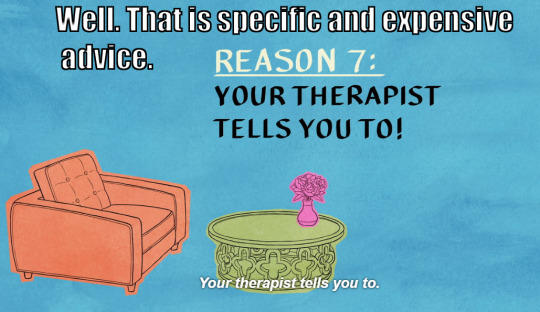
In all my years of seeing therapists, not once has any of them advised me to fly to the capital of Vietnam.
Diane’s therapist also gossips about the non celebrities she sees. Including Demi who had a first husband named Bruce and a second named Ashton. And a client named Angelina J., who does not think of herself as an actress anymore.

An actress, a director, a humanitarian, a savior of all mankind, all in a painfully obvious attempt to keep the spotlight on her.
Yeah, I am not much of a Jolie fan.
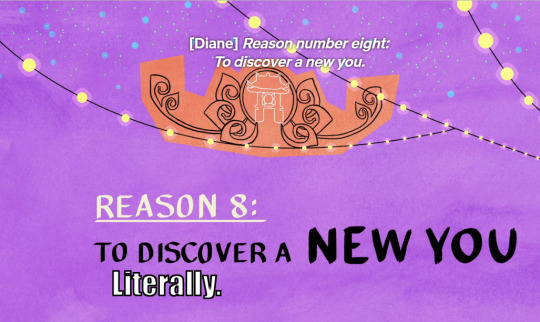
Diane meets American Bald Eagle working on the Laura Linney movie at the bar and helps him order a drink. He thinks she’s a Vietnamese citizen. They walk through Hanoi’s market area, he tells her about his life in America, thinking she cannot understand a word he is saying, and she kisses him.
I have no bloody idea how you tongue a dude with a beak. There must be some particular angling involved.
American Bald Eagle takes her to Ha Long Bay...the set. It’s actually a backdrop for the Laura Linney movie. American Bald Eagle is the executive grip on the crew. He is Very Important. Or so he claims. But then, as they are perplexedly kissing again, a klieg light falls beside them and Diane curses. In English.
The jig is up!

Diane tries to defend her actions but American Bald Eagle ain’t havin’ it. She’s the bad guy here!
Diane is NOT having it, y’all.

Oooh, mic drop!

Number 9 reason to go to Vietnam:
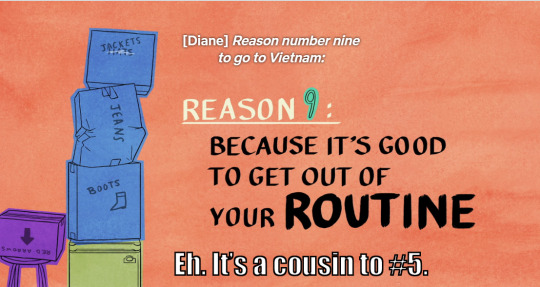
She worries that this is similar to reason #5, which is Get Out Of Your Natural Habitat, but it’s whatever. Diane is getting divorced, she is owed a whatever.
In flashback, Diane has just chopped off her hair and she is wearing a kick jumpsuit looking all fly ready for her ex’s party but when BoJack arrives and compliments her she flies off the handle a bit, accusing him of trying to take advantage of her when she is vulnerable. He sighs and leaves, telling her that Mr. Peanutbutter will love her new hair.
At the party, Todd is wearing what he always is and eyes the ice swan greedily. Yes, he will lick it tonight. Oh, yes he will.

Oh, Todd. You are a delight.
Diane wanders into the library that used to be hers (her Belle-room) and bumps into Mr. Peanutbutter dressed in a tuxedo shirt and what look to be electric blue plastic pants. Carrying a dog bowl full of nachos.

Mr. Peanutbutter mumbles that she looks good. The new haircut really brings out her...neck. It is all really awkward and uncomfortable and Mr. Peanutbutter quickly finds an excuse to greet someone else.
PC hugs Diane and cries that she saw the whole thing; she will be her rock as long as it does not interfere with being Mr. Peanutbutter’s rock because they are both her friends and it also cannot interfere with her work, which is keeping her very bizzay.

There are a lot of heartbreakingly awkward moments in this episode. I kinda sympathize with PC, though. It’s always a fragile position to be in, being a friend of both parties in a divorce. There’s a fine line you have to tread.
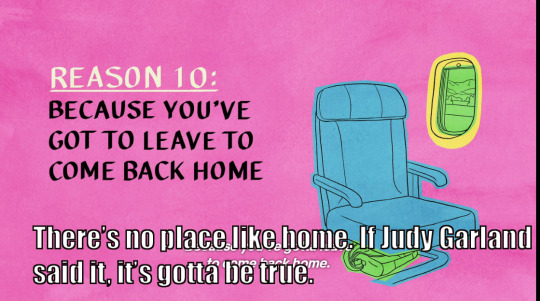
In the present, Diane gets on a plane in Hanoi and calls BoJack to apologize for how shook she’s been post-divorce. She really just needs a friend right now. Get that, BoJack? A friend.

No more yanky your wanky, BoJack.
Or maybe do.
On the plane, none other than Laura Linney sits down beside Diane.

After she gets over her initial star struck reaction, Diane asks her how her movie ends. Does Laura find herself in Vietnam? Well, yes. Literally. She finds her clone sleeping with her ex. And they team up to take down the government.
Someone call Alex Jones!

But those, Diane says in VO, are not the real reasons to go to Vietnam. The real reason is because you see your ex-husband kissing someone else at a party.
Mr. Peanutbutter picks Diane up from the airport, we are shown the uncomfortable exchange from the first episode in his car, and just as she is about to leave with the signed divorce papers, Mr. PB admits that he is seeing someone. Who is not her.
Flashback to the party. PC is still rambling on about being supportive while talking on her phone about work related stuffs when Diane spots her ex and Pickles through a window. She kisses him, and, at first, Diane waves it off as just Mr. PB being drunk. Then, the golden retriever and the pug kiss more thoroughly, and poor Diane is crushed.

There. You can fully see the shock and heartache in her eyes, rendered perfectly through simple animation. Another reason why I heart this show so much.
Because even though she left him, even though she knows she made the right choice, it still frigging HURTS. Like shards of glass pricking her heart.

The heart is an unreasonable muscle.
Diane spends the next few frames drifting through her days. At her shithole apartment. At BoJack’s. On the plane. Even in Vietnam. In VO, she tells us she had hoped the vacation would give her some perspective, but it doesn’t. When she returns, she feels worse than ever.
And that is okay. It’s okay to ache. It’s okay to be confused. When your heart is crushed, nothing makes sense.
So, back in the present, Diane takes a deep breath, smiles a little, and says--
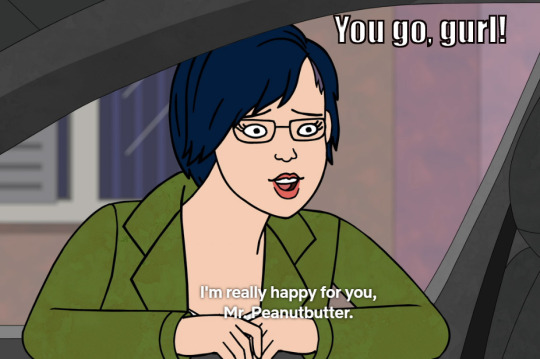
Wow, that was a great episode! I mean, they are all great, but this one was particularly awesome. Took FOREVER to cap, tho. I loved the artistry of the animated Vietnam, how beautiful Ha Long Bay and the Pagoda looked even rendered in animation. The attention to detail is exquisite.
The emotions were so real. When our hearts ache, whether it be after a horrible break up or a divorce or any kind of tragedy in our lives, we tend to be erratic like Diane was in this episode. We lash out at our friends. We try to doll ourselves up when we know we’re going to see ex boyfriends or girlfriends. We feel as if we’ve been stabbed when we glimpse them moving on when we cannot. Sometimes, we take unplanned trips. Or some of us spend a lot in lieu. I could not take such a trip as Diane took after the worst breakup of my life because I was in the middle of a semester...so I spent money at the local mall. Everything I earned. My paycheck was GONE as soon as I got it. I think I spent over a grand in one month alone.
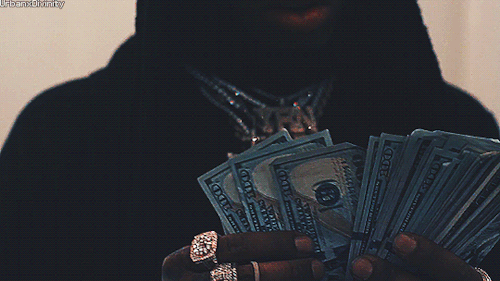
We find ways to cope. And eventually, we start on the road to becoming okay again.
2 notes
·
View notes
Link
via Politics – FiveThirtyEight
Graphics by Ella Koeze
Quantitative analysis by Mai Nguyen
When Dawud Moore heard he’d been assigned bail, he felt relieved. It was January 2015, and Moore, a black man who was a 38-year-old Brooklyn resident at the time, was in an arraignment hearing on forgery charges — he had cashed a paycheck that his employer claimed was fraudulent. He maintained then and now that the company accidentally paid him twice, once in person and once by mail. The company claimed he’d forged a duplicate check.
All things considered, the $10,000 bond1 felt manageable. Moore had been arrested before, including for a drug-related conspiracy charge that put him in federal prison for nearly a decade. This time he was a little more than a year out of prison and had several months of steady work as a mason under his belt. He had a little bit of cash in his bank account, enough to pay the bondsman and make bail. Posting it would allow him to be released from jail while he awaited trial, and Moore was familiar enough with the system to know that he was much more likely to beat the case if he wasn’t locked up. “It’s funny because this is the first time in my adult life where I got a bail,” he said recently. “I was thinking, ‘I’m working, I’m out of trouble, I can pay this.’ And I know I didn’t do anything wrong,” Moore said.
But not all judges in New York City treat bail the same way. A FiveThirtyEight analysis of 105,581 cases handled by The Legal Aid Society, the largest public defender organization in New York, found that how much bail you owe — and whether you owe it at all — can depend on who hears your case the day you’re arraigned.
New York’s judges are assigned to arraignment shifts, hearing every case that comes into the court during that time. Because the assignments are random — judges hear cases solely based on when people are arrested and how busy the court is — we can identify whether defendants are being treated equally regardless of who hears their case. They are not.
In New York City, when clients of The Legal Aid Society who were charged with a misdemeanor in 2017 entered their initial arraignment, they had anywhere between a 2 and 26 percent chance of the judge setting a cash bail, depending on which judge was randomly assigned to oversee the court that day. For felonies,2 the range was even wider: anywhere between 30 and 69 percent. Those not assigned bail are likely to be released without having to pay, which means getting arrested on the wrong day can have a major consequence: You are more than twice as likely to have to pay your way to freedom. Can’t find the money? You’re stuck in jail.
Moore, who was a Legal Aid client, found a bondsman. But when the bondsman went to the court to post Moore’s bail, he had to go to the New York County Supreme Court judge now assigned to his case. (After an initial arraignment, felonies are moved to a different court system.) That judge, Charles Solomon, said the bail set by the initial judge was too low, and the amount Moore had paid the bondsman as security on his bond, a total of $1,600, wasn’t sufficient given Moore’s criminal history, according to transcripts of the court proceedings.
Moore’s lawyer protested,3 but Solomon declined to tell Moore’s lawyer what amount would be an acceptable collateral. At a subsequent hearing, he raised the bail to $25,000. Moore says his family got more money together and gave it to the bondsman, but Solomon continued to refuse it.
Judges do not comment on the details of individual cases, according to a spokesperson for the New York State Unified Court System, and Judge Solomon retired late last year. But while Moore was locked up, the court argued that Solomon’s refusal to accept the bond was not an abuse of his discretion because he made it clear that he planned to increase the bail after Moore received a felony indictment, citing relevant aspects of Moore’s criminal history.
Moore says he spent 10 months locked up, most of it in the notorious jails on Rikers Island, a 400-acre island in the East River that’s home to New York City’s main jail complex.
His time on Rikers included some of the most violent months in the jail system��s history. Working in the medical unit,4 he remembers seeing other inmates come in on stretchers with stab wounds and other injuries on what felt like a daily basis. “I’m not going to say that because I spent 10 years in [federal] prison, I’m tough,” Moore said. “No, I was scared.”
Desperate to get off the island, Moore pleaded to a misdemeanor, a fine and time served.
Moore’s case is not typical. FiveThirtyEight spoke with several public defenders who said that while it’s not unheard of, it is rare for a judge in New York City to demand additional collateral before accepting a bail posted by a bondsman. But it does highlight a feature of the bail system in many parts of the country: Judges have wide-reaching discretion to decide how much bail a defendant must pay — discretion that judges deploy in very different ways.
Random justice
For several years, politicians on the national and local level have been wondering what to do about America’s bail system. Few are happy with it. Empirical research has suggested that it has deleterious consequences for defendants, the penal system and recidivism rates. FiveThirtyEight’s findings add another layer to previous reports about the system’s inequality.
This FiveThirtyEight analysis covers all arraignments in criminal court in New York City in 2017 that are handled by The Legal Aid Society, which represented about 60 percent of all individuals arrested in the city last year. (By nature of qualifying for a public defender, the defendants involved are people who would likely struggle to pay bail.) In our analysis, we only looked at the initial arraignment in each case (some cases have follow-up hearings, which we did not include), and we have excluded cases that were dropped or concluded on the day of first arraignment. We categorized judge decisions as one of the following: bail greater than $1, which is cases where cash bail was set; remand, which is when defendants are held without bail; or released without bail or bail of $0, which groups together cases where people were assigned non-cash forms of bail, received supervised release, or were released on their own recognizance. The data did not allow for us to do any demographic analysis, so we don’t know if bail rates differ depending on, for example, the race of the defendant.
More on the methodology can be found in the footnotes.5
Where a person is arraigned also matters. New York City has five boroughs, each with its own criminal court and a unique culture when it comes to bail setting, according to people who work in the court system. Moore’s case was filed in Manhattan because that’s where the construction company reported the crime; 58 percent of felonies there were assigned bail in 2017,6 according to FiveThirtyEight’s analysis. In Brooklyn, where Moore lives, 47 percent of felony cases were assigned money bail.7
FiveThirtyEight requested interviews with the New York State Unified Court System and the judges who appear in the data, and emailed a list of questions about bail-setting practices. In response, the courts issued a short statement:
“The setting of bail or bond in New York state is solely up to the presiding judge on the particular case. The particular type and amount of bail, or whether bail is appropriate at all, for the defendant, is advocated by both the prosecution and defense bar with the final determination coming from the presiding judge.
The New York State legislature promulgates the laws and that would include any changes to New York’s bail statutes.”
What role does bail serve?
Bail was created as a way to get people out of jail while they await trial by providing an incentive to make sure they show up for subsequent court dates. But today, jails around the country are filled with some 450,000 people who are being held pretrial. And just a few days in jail can have significant consequences.
Research has found that when a defendant is not granted bail or cannot pay it and so winds up being held in custody while they await trial, that leads to worse outcomes for defendants, including a greater likelihood that they will plead guilty to crimes and receive worse deals from the prosecutor’s office. A study of cases handled by The Legal Aid Society in 2015 found that setting bail led to a 34 percent increase in the likelihood of conviction. Even small amounts of bail are prohibitively expensive for the vast majority of people for whom they are set, and short stays in jail can often lead to lost jobs and housing issues. For poor defendants, awaiting trial in jail, even if the charges turn out to be false or are for only a minor offense, can lead to major crisis. And holding people prior to trial costs taxpayers around $13.6 billion a year, according to one study.
In recent years, the American Bar Association, the New York State Bar Association and even some prosecutors have supported efforts to limit the use of cash bail in favor of supervised release or releasing more people on their own recognizance. At the beginning of 2018, Manhattan District Attorney Cy Vance directed his assistants not to request bail when they brought charges for nonviolent misdemeanors.
“There’s a real opportunity for judges … to look at their bail-setting practice and be able to reduce the pretrial population with the tools they already have at their disposal.”
But despite this momentum toward reducing the use of bail, many prosecutors continue to ask judges to set bail, and many judges continue to agree.
“Why in the world would we keep people in [jail], in these inhumane conditions that exist in many of our jails, when there’s no reason, when those people should be home with their families and their communities,” said Judge Jonathan Lippman, former chief judge for the state of New York and chair of an independent commission on criminal justice and jail reform in NYC.
Lippman and the commission have advocated to end cash bail entirely, saying there is no evidence that it is more effective than other forms of bail at increasing the likelihood that people will return to court for hearings.
He would, however, like judges to be allowed to consider public safety when they are deciding what to do with a defendant awaiting trial, which is not currently allowed in New York. Lippman is sure that some judges in some cases set cash bail because they are worried about the crimes a person may commit if they are released before their trial. “It is a fiction that judges don’t consider public safety,” he said. But, like many critics of cash bail, he believes that the current system frequently penalizes the poor and is particularly harmful to communities of color.
In 2016, just 15 percent of bails were paid at arraignment for non-felony cases. For felony cases, it was 8.8 percent.
In Moore’s case, the bail decision by the second judge put Moore in jail for the better part of a year, which in turn damaged his relationship with his family and friends, relationships he’d been trying to repair since he’d been released from federal prison. “Everyone is like, ‘It must be serious if the judge isn’t letting you out.’”
New York’s bail problem
New York City has been searching for an answer to its bail problem for years. In 2014, The New Yorker reported on the case of Kalief Browder, a teenager who was accused of stealing a backpack and spent three years on Rikers as a result, much of it in solitary confinement. His case was later dropped, and in 2015 he killed himself.
In response, the New York City Council Speaker requested an independent commission, the one chaired by Judge Lippman.
In addition to recommending that New York stop using money bail, the commission also found that Rikers is beyond redemption and recommended shutting down the jail complex altogether. In 2017, de Blasio said he wanted to close Rikers within 10 years. The Legal Aid Society’s data suggests that if the judges who were most likely to set bail in 2017 instead started setting bail at the median rate, the inmate population could be reduced by several thousand people — which would go a long way toward helping to close Rikers.
“There’s a real opportunity for judges … to look at their bail-setting practice and be able to reduce the pretrial population with the tools they already have at their disposal,” said Jane-Roberte Sampeur, a staff attorney with The Legal Aid Society.
All this data from New York points to one of the reasons that state and local governments are moving to limit the use of cash bail across the country. It’s been several decades since someone was held because of their inability to pay bail in Washington, D.C., for example, the defendant’s financial circumstances are taken into consideration when cash bail is set.
New York, though, hasn’t yet followed suit, despite significant efforts to move the state away from the cash bail system. The state assembly recently approved legislation that would end the use of cash bail for most misdemeanors and nonviolent felonies. But with two working days left in the state’s legislative session, the bill is not expected to be passed by the state senate, which means it can’t become law this term. However, activists, lawmakers and public defenders say they remain hopeful that there will be legislative change next year.
In the meantime, New York City has reduced its use of cash bail. Advocates of bail reform have been encouraging judges to release more people without asking for any kind of bail, or to make more frequent use of other kinds of bail — things like unsecured bonds, which amount to a promise to return to court or pay a fine. The city also recently created a large-scale program for supervised release, which allows judges to let people out without bail, but requires that the defendants do things like check in with the court, similar in some ways to parole.
George Grasso, the supervising judge for Bronx county criminal court, was involved in creating that program. He says judges must be aware that setting bail can potentially lead to a long stay in Rikers. “We have a lot of good alternatives if we’re concerned about [a defendant’s] appearance” at later court dates, he said. He also pointed out that though there’s a lot of attention on New York City’s criminal justice system, it releases people without bail far more often than other parts of the U.S.
“What we do in New York City — in wide swaths of the country, from the defense perspective — would be nirvana,” said Grasso.
The problem is bigger than New York City
Bail-setting practices are no more consistent in upstate New York. In Erie County, where Buffalo is located and where 64 percent of people in one local jail are waiting for their trials, people charged with minor misdemeanors are routinely asked to pay bail, according to research by the Partnership for the Public Good, a community-based think tank in Buffalo. Pretrial data is hard to come by and bail data is not made publicly available, so from Nov. 2017 to Feb. 2018, the group sent court watchers to observe 240 arraignment hearings.
They found something similar to what FiveThirtyEight found in New York City: Cash bail was set in 64 percent of hearings and defendants were released in 33 percent of cases, but the frequency varied dramatically between judges. One judge set bail in 46 percent of all cases, while another set bail in 92 percent.
Bail-setting practices are inconsistent elsewhere too
Share of felony and misdemeanor arraignments where bail was set by five anonymous judges in Buffalo, New York, from Nov. 2017 to Feb. 2018
share of cases where bail was set Judge Misdemeanors Felonies 1 83%
–
–
100%
–
–
2 72
–
–
90
–
–
3 55
–
–
83
–
–
4 67
–
–
77
–
–
5 42
–
–
59
–
–
Source: Partnership for the Public Good
When the Partnership for Public Good compared cases with similar backgrounds and charges, the group found that there seemed to be differences in both how often bail was set and the amount it was for depending on what judge happened to be presiding the day a person landed in court, said Andrea Ó Súilleabháin, deputy director at the organization. And the different approaches that showed up in the data were also recognizable in the courtroom. One judge regularly asked defendants about their ability to pay bail, while one judge assigned bail to a defendant (after initially approving him for a supervised release program) after scolding him for slouching in his chair. “It’s almost bail as punitive, we could see that feeling in the courtroom,” said Ó Súilleabháin.
Judge Paula Feroleto, the administrative judge for New York’s Eighth Judicial District, which covers Buffalo, agreed to an interview with FiveThirtyEight, but declined to comment on questions relating to cash bail, noting only that judges follow the law.
Ó Súilleabháin said that PPG’s interviews with judges in the Buffalo area suggest that there are cultural explanations for the heavy use of cash bail. Some judges said they fear that someone who was released would commit a violent act while awaiting trial. Others said they believe their constituents want a conservative approach. (Many judges are elected in New York state.) One judge even told PPG that judges sometimes use high bail as a way of clearing crowded court dockets, trying to force people to plead out.
If a court is really using its discretion, said Rebecca Town, a public defender in Buffalo, then judges will set bail using the method that is the least onerous for the defendant while still being robust enough to get the person to return to court. “Our courts are not using the flexibility they have,” she said, noting how rarely non-monetary forms of bail are used in Buffalo.
How far will reform go?
Even in places moving to end the use of cash bail, the conversation is usually limited to first-time offenders or people charged with misdemeanors. Reforms likely wouldn’t apply to people like Moore who are charged with felonies or already have criminal records. And even though felonies tend to be more serious crimes, it’s not uncommon for charges to be brought on questionable evidence.
Darryl Herring, a 61-year-old black man, recently moved into his first steady apartment in many years. Before finding his current home, he had fled the putrid aftermath of Hurricane Katrina for New York, the city where he grew up, then lived in a series of homeless shelters before finding himself on Rikers Island for almost two years.
In July of 2015, a female acquaintance from the shelter where he was living at the time accused him of rape. He was assigned a bail of $75,000 at arraignment, but Herring said it would have been impossible for him to pay even $100. His attorney advised he plead to a lower charge, which would likely have put him on a sex offender registry for the rest of his life. But a plea bargain was never an option as far as he was concerned. “I was 58 when they picked me up. Any sentence to me was a death sentence.”
Since his stay on Rikers, which included endless days on lockdown due to the rampant fighting among younger inmates, he says he hasn’t been able to sleep through the night. “The psychological effect is the worst part,” he said. “It really got your mind down.”
Weak discovery laws in New York meant the prosecution didn’t have to hand over its evidence until right before trial, but when Herring’s attorney and the judge finally got a look at the prosecutor’s case — 18 months after Herring’s initial arrest — he was quickly acquitted. Herring’s file is sealed, but he says that the records showed that information gathered by the police and prosecutors cast significant doubt on the accuser’s statement, and physical evidence failed to link him to the accuser.
And like that, he was released. He’d been found guilty of no crime.
“People who haven’t been through it, they gotta think it can’t be that bad.” Herring said. “But it is.”
4 notes
·
View notes
Text
ES Spectre Interlock Chapter 01-10
1 note
·
View note